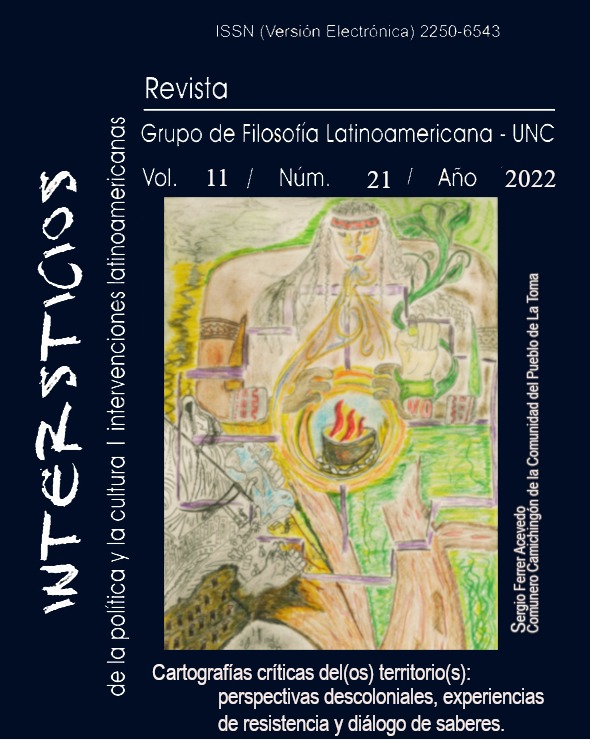Shepherds, Weavers and Butterflies.Thinking about relationships through affection
Keywords:
wild silk, affectivity, relationships, breeding, ancestral practicesAbstract
This article, by way of ethnography, approaches the inhabitants of the Sierra de Ancasti, province of Catamarca, and tries to highlight how some traditional and ancestral customs are kept alive, and intertwined in day-to-day life. The coyoyo or wild silk weavers keep alive a practice that, as part of a family task, requires a coordination of efforts, as well as the raising of animals. Both tasks show the strong relationship of affectivity and linkage in which humans, animals and the forest are involved. Local knowledge, learning, experiences, stories and past times that are also present appear, interwoven like silk.
Downloads
References
Arnold, Denise; Yapita Juan de Dios y Espejo Elvira (2007) Hilos sueltos: los Andes desde el textil. ILCA. Plural editores.
Barabás, A. M. (2008) Cosmovisiones y etnoterritorialidad en las culturas indígenas de Oaxaca. Antípoda N°7. Pp 119-139.
Chiriboga Cisneros, Fernando E. y F. M. Mora Méndez (2017) Turismo agroecológico: Alternativa de desarrollo turístico sostenible en la zona rural de la provincia de Guayas. INNOVA Research Journal. Vol 2. N°5. PP 152-162. UIDE. Guayaquil.
Contreras, Ramón (2015) Antropología y campesinado. La persistencia de lo persistente. Reflexiones antropológicas en torno al internacionalismo campesino. Cultura, Hombre y Sociedad 25. Pp 9-43.
De la Fuente, Nicolás (1979) Nuevos descubrimientos de arte rupestre en la región de Ancasti, Prov. de Catamarca. Centro de estudios de Regiones Secas.
Escobar, Arturo (2016) Sentipensar con la tierra. Las luchas territoriales y la dimensión ontológica de las Epistemologías del Sur. Revista de Antropología Iberoamericana. www.aibr.org. Vol. 11. N°1. Pp 11-32.
Fernández, Luciana (2022) Cuerpo territorio, entierro de placentas y ritos fundacionales. Revista Cambios y Permanencias. Vol. 13, N°1. Pp219-233.
González, Rodrigo y Alejandro Mantecón (2014) Turismo y negocio inmoviliario: La crisis de un modelo de desarrollo. Tres estudios de caso de Canada, Argentina y España. Estudios y Perspectivas en Turismo. Vol. 23. Pp 685-705.
Guber, Rosana (2004) El salvaje metropolitano. Reconstrucción del conocimiento social en el trabajo de campo. PAIDOS.
Haber, Alejandro F. (2011) Animismo, relacionalidad, vida: perspectivas post occidentales. En: D. Herno y L. Miotti (Eds.) Biografías de paisajes y seres:visiones desde la arqueología sudamericana. Encuentro Grupo Editor. Córdoba, Argentina. Pp 75-98.
Haber, A. F. (2015) Arqueología indisciplinada y descolonización del conocimiento. En: Arqueología y decolonialidad. Ediciones Del Signo. CABA. Pp 123-166.
Illich, Ivan (1977) Después de la escuela ¿Qué?. En: Un mundo sin escuelas. Editorial Nueva Imagen. México DF. Pp 9-41.
Jurado Cazaux, Graciela y Adriana Zapata (2018) Polillas y tejidos de seda en bosques nativos de Argentina. Revista de la Facultad de Ciencias Exactas, Físicas y Naturales. Vol. 5. N°1. Universidad Nacional de Córdoba. Pp 77-82.
Kriscautzky, Nestor y Elena Gómez (1984) Tecnología apropiada de origen precolombino. Artesanías de América N°17. Pp 81-90.
Malinowsky, Bronislaw (1986) Los argonautas del Pacífico occidental. PLANETA-AGOSTINI.
Nazar, Domingo Carlos (2003) Parque Arqueológico La Tunita. Puesta en valor integral del arte rupestre de la vertiente oriental de la Sierra de Ancasti. Tesis de maestría. Universidad Internacional de Andalucía.
Nazar, Domingo Carlos; Doulout, Luis Noel; Rodríguez, Martín Lucas (2013) Puesta en valor y manejo integral del patrimonio. La problemática socio ambiental del Parque Arqueológico La Tunita, Sierra de Ancasti (Catamarca, Argentina) Cuadernos de la Facultad de Humanidades y Ciencias Sociales. Universidad Nacional de Jujuy 44, Jujuy, Argentina. Pp 153-173.
Nazar, D.C.; de la Fuente, Guillermo y Lucas Gheco (2014) Entre cebiles, pinturas y cuevas. Una mirada a la estética antropomorfa del arte rupestre de la Tunita, Catamarca, Argentina. Boletín del Museo Chileno de Arte Precolombino, Vol 19, N° 1, Santiago de Chile. Pp 37-51.
Pazzarelli, Francisco (2013) Arnold Denise Y. Y Elvira Espejo. El textil tridimensional. La naturaleza del tejido como objeto y sujeto. Journal de la Societé des americanistes, tome 99 N°2.
Downloads
Published
Issue
Section
License

This work is licensed under a Creative Commons Attribution-NonCommercial-ShareAlike 4.0 International License.
Authors who have publications with this journal agree to the following terms:
a. Authors will retain their copyright and grant the journal the right of first publication of their work, which will simultaneously be subject to the Creative Commons Attribution License that allows third parties to share the work as long as its author and first publication in this journal are indicated.
b. Authors may adopt other non-exclusive license agreements for distribution of the published version of the work (e.g., deposit it in an institutional telematic archive or publish it in a monographic volume) as long as the initial publication in this journal is indicated.
c. Authors are allowed and encouraged to disseminate their work through the Internet (e.g., in institutional telematic archives or on their web page) after the publication process, which may produce interesting exchanges and increase citations of the published work (see The effect of open access).


